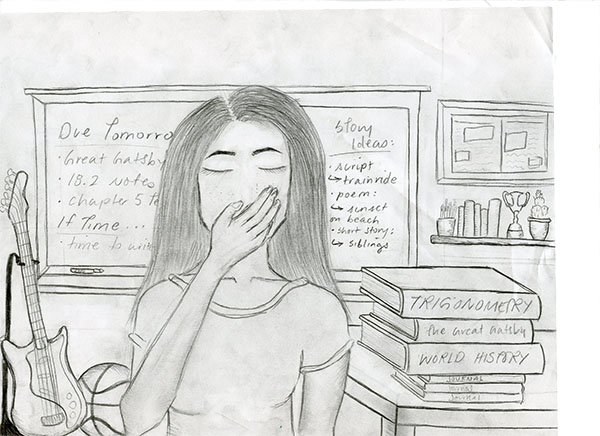Creative Writing provides time, space to craft skills
December 22, 2017
Room 160 is dim, lit only by a few glowing lamps and the afternoon sunlight streaming through the windows. English Teacher John Allen, who teaches Creative Writing, kicks off each class with the DayBook, a five minute journal entry. Today’s prompt: “Three constructive ways to improve your DayBook responses.” The room went silent save for the tapping of keyboards. Session 33 of the Creative Writing class had begun.
According to Allen, the course’s goal is to give students a time and place to write apart from the hubbub of normal life. He says the only way to improve at a craft is to focus on it and devote time to it.
“It’s important to have dedicated, [undisturbed] time that totally focuses on that creative work,” Allen said.
Junior Claudia Park, who took the course under Allen’s instruction last year, says she enrolled in the class due to the committed 90 minutes of creativity that it offered. According to Park, Allen helped to push the envelope when it came to their work.
“During the school year, it’s really hard to write, but in a way, [through this class], you’re forced to write and forced to be creative,” Park said.
Allen believes a major appeal of the class is the prospect of writing in a setting alongside other passionate authors. Exposure to others’ styles, he says, is essential to perfecting one’s own. According to Allen, constructive criticism from peers is an important part of the class.
“When you have that support of other students, you get encouragement, you get an audience, you get feedback on the things that you care about most,” Allen said.
After the DayBook is complete, the class moves on to the Writer’s Workshop, which consists of studying a sample of creative writing by a professional author. Students are then encouraged to imitate the style of the excerpt, whether in their overarching project or a separate piece.
“We look at the moves that creative writers make, try to identify [them], and then add those into the skills that the student already brings into the room,” Allen said.
The Writer’s Workshop had a profound effect on junior Macy Galante, who says the exposure to the voices of others helped her embrace her own, as well as notice art in everyday life.
“[Allen] would show us a lot of different types of works by different people and I definitely appreciate beauty way more than I did before,” Galante said.
The class ends with time to work on students current projects. According to Park, these projects include a poem, a script, a short story and a piece of creative nonfiction. During this time, students have an opportunity to conference with Allen, though Park says that Allen’s advice still allows for the individual’s writing style to be maintained.
“In a sense, he’s not [involved with the writing process] because he’s allowing us to write on our own, but as a mentor he is,” Park said.
At the end of the semester, the work is compiled into an online portfolio. Galante says the portfolio allows her to share her work with others, as well as see how she has grown. Allen emphasizes the portfolio as a concrete goal, but expressed a more abstract aim to the course overall.
“For me as a teacher, I want them to have a deeper experience of beauty, because I think people who have a deeper appreciation for beauty are people who are going to connect with others,” Allen said.



